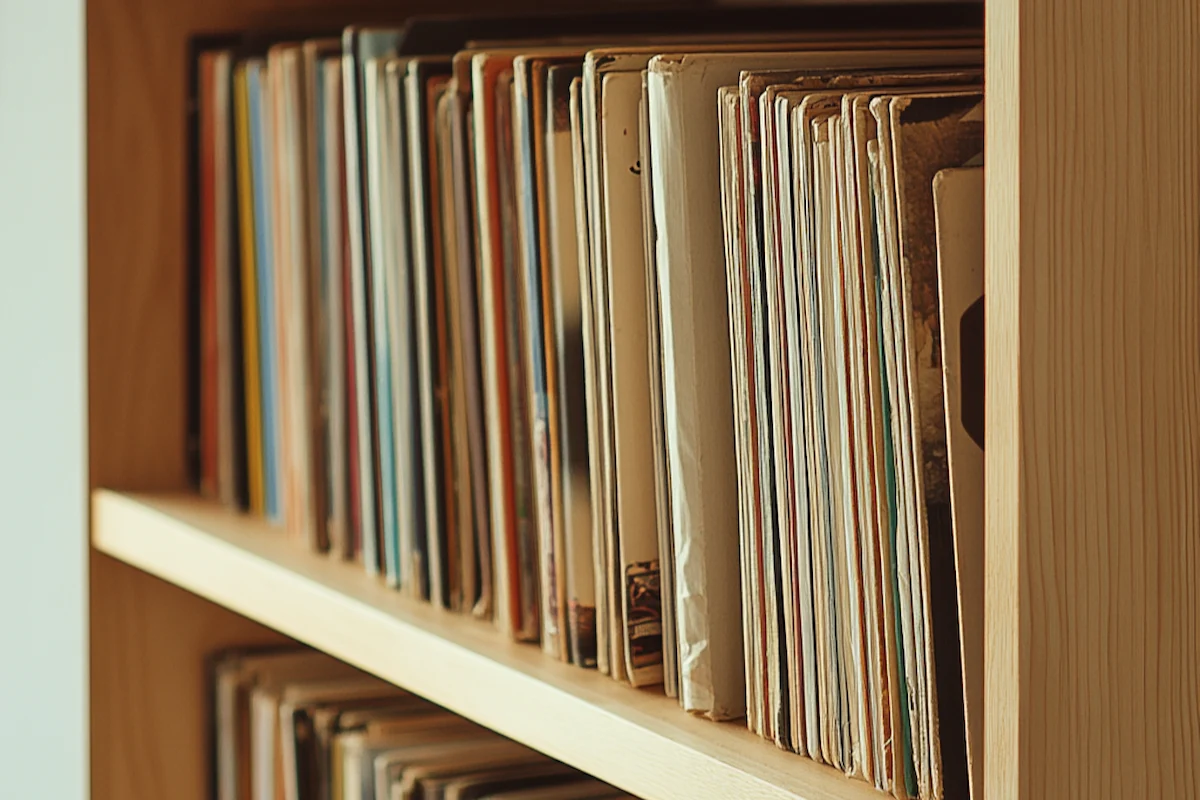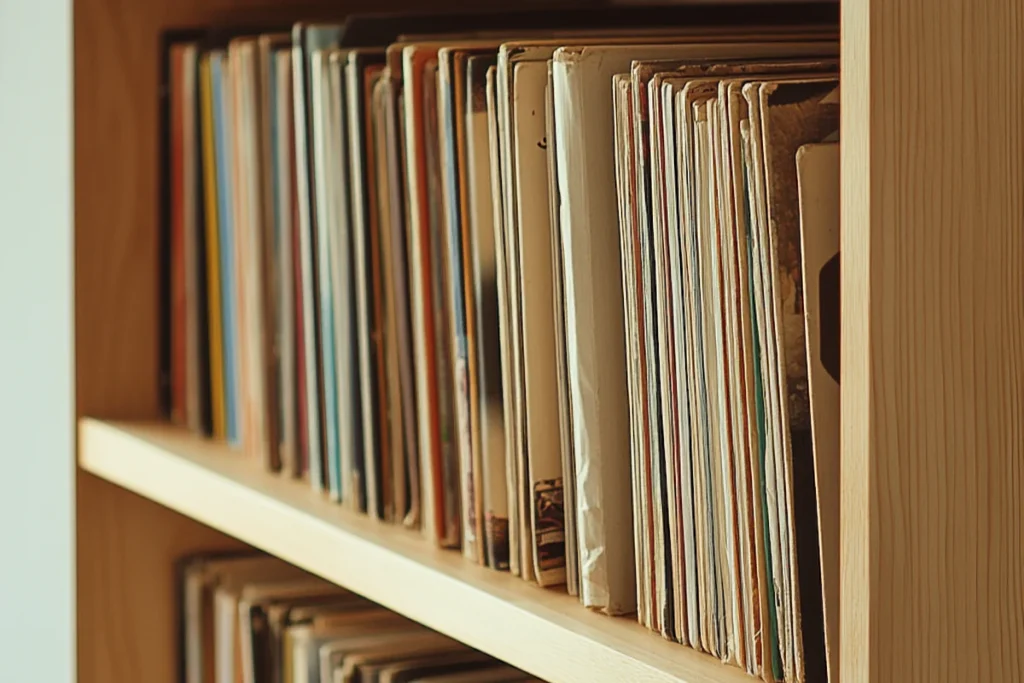Organizing a vinyl record collection can be gratifying, especially when it spans multiple formats like 45s, LPs, and even 78s.
Each format offers unique appeal, and having a methodical system to store and categorize your collection makes it more enjoyable and helps preserve its value and condition over time. Whether you’re a seasoned collector or just starting, knowing how to organize your mixed-format collection can make all the difference.
Why Organization Matters When Selling Your Vinyl Collection
At DJ Records™, we understand the importance of maintaining a well-curated collection. As buyers of vinyl records, we often see collections that range from neatly organized to chaotic stacks, and we know how proper organization can add value and simplify the selling process when the time comes.
Understanding the Differences: 45s, LPs, and More
Before diving into organizational strategies, it’s essential to understand the key differences between formats:
- 45 RPM (7-inch records): These smaller records often feature singles with one song on each side. They’re compact, but their sleeves are more fragile, making proper storage essential.
- LPs (Long Play, 12-inch records): LPs are the standard format for albums, and their larger size allows for more intricate artwork and extended playtime.
- 78 RPM: These vintage records are made from shellac rather than vinyl and are more fragile, requiring extra care when storing and handling.
Each format has its own storage and organizational challenges, especially when mixed into one collection.
Step 1: Categorize by Format
One of the most straightforward ways to organize your collection is by format. Separating your 45s, LPs, and 78s makes finding what you’re looking for easier and ensures each format gets the specific care it needs.
- 45s: These records can be stored in boxes or crates designed for 7-inch records. Use dividers or separators to prevent the sleeves from bending or folding over time.
- LPs: Store LPs upright in sturdy shelves or crates to prevent warping. Avoid stacking them flat, as the weight can damage the records at the bottom.
- 78s: Due to their fragility, 78s should be stored in dedicated sleeves and kept away from high-traffic areas where accidental bumps or drops could occur.
You’ll create a foundation for the more detailed organization by categorizing your collection by format.
Step 2: Organize by Genre or Artist
Once you’ve separated your collection by format, consider organizing by genre or artist. This method benefits collectors with diverse tastes, letting you quickly locate specific music or artists.
For example:
- Group your LPs by genre (e.g., rock, jazz, pop) and then alphabetize by artist within each genre.
- Similarly, arrange your 45s and label or mark dividers for quick access.
- For the 78s, consider organizing by time period or label, as these records often have historical significance tied to specific eras.
Step 3: Label and Inventory Your Collection
A sound organizational system is only as effective as the tools you use to maintain it. Labeling and inventorying your records can save you time and effort, especially if you have an extensive collection.
- Physical Labels: Use dividers with clear labels for each section (e.g., “Classic Rock LPs” or “Jazz 45s”). This keeps everything neat and accessible.
- Digital Inventory: Consider using an app or spreadsheet to catalog your collection. Include the artist, album name, format, condition, and purchase date. This can also help you track the value of your collection over time.
An inventory makes it easier to track what you own and is helpful if you ever decide to sell part or all of your collection. At DJ Records™, we appreciate well-organized collections, allowing us to evaluate them more efficiently.
Step 4: Store Properly to Preserve Condition
Proper storage is crucial for maintaining the quality and value of your collection. Here are some tips for storing different formats:
- Use Protective Sleeves: Invest in high-quality inner and outer sleeves for 45s and LPs. These sleeves protect records from dust, scratches, and static.
- Climate Control: Store records in a cool, dry place away from direct sunlight. Heat and humidity can cause warping and sleeve deterioration.
- Upright Storage: Always store records upright to prevent warping, and avoid over-packing shelves or crates, which can cause unnecessary pressure on the sleeves.
- Avoid High-Traffic Areas: Especially for fragile formats like 78s, store records in a location where they’re less likely to be accidentally bumped or knocked over.
Step 5: Consider Selling or Trading
As you organize your collection, you may encounter duplicates, records you no longer listen to, or items that don’t fit your focus. Selling or trading these records can help refine your collection while allowing others to enjoy them.
At DJ Records™, we specialize in buying vinyl record collections of all formats. Whether you want to downsize, sell duplicates, or part with your entire collection, we’re here to help. While we don’t guarantee any specific outcomes, we’re happy to evaluate your records and provide an offer.
Making Organization an Ongoing Habit
Once you’ve organized your collection, it’s essential to maintain your system. Update your inventory regularly, check for any signs of damage, and adjust as your collection grows or changes.
Organizing a mixed-format collection can seem daunting, but with a little effort and the right approach, it becomes an enjoyable way to interact with your records. A well-organized collection makes finding and enjoying your favorite music easier and ensures your records stay in top condition for years to come.
If you’re ready to sell or have questions about your collection, DJ Records™ is here to assist. Contact us today to learn more about our process and how we can help you find new homes for your records.
WE BUY OLD RECORDS!
We’ve been buying LPs, 45s, 78s & 12″ singles for well OVER 20 YEARS.
No collection is too large!










1 thought on “From 45s to LPs: Organizing a Mixed-Format Collection”
Comments are closed.